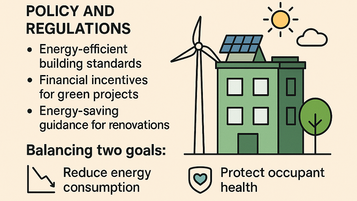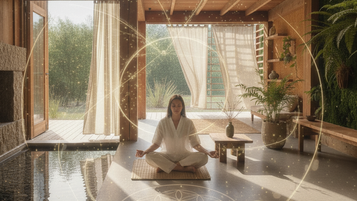1. Disconnection from Nature – Loss of Biological Rhythm

Modern homes are often sealed: small windows, reflective glass, constant air conditioning, and bright LED lights all night long.
When natural light, wind, and temperature are cut off, our biological rhythms become disrupted.
Our bodies are designed to live with the sun:
-
In the morning, natural blue light stimulates cortisol production — awakening energy.
-
At night, warm light and darkness promote melatonin — the sleep hormone.
In modern homes, artificial light dominates both day and night → the brain can no longer tell day from night → insomnia, fatigue, mild depression.
Science calls this circadian desynchronization — a root cause of many urban health disorders.
2. Sensory Overload – “Pollution of the Senses”

Humans have five senses, but modern homes overstimulate them all:
-
Sight: strong colors, artificial lights, screens.
-
Hearing: humming of air conditioners, fridges, traffic noise.
-
Smell: synthetic materials, paints, plastics.
-
Touch: cold, smooth surfaces, lack of natural textures.
The brain constantly processes chaotic sensory signals → leading to sensory fatigue.
As a result, people feel uneasy, restless, or irritable — without knowing why.
3. Air That Doesn’t Breathe – Stagnant Energy

A truly healthy home must “breathe”:
-
Natural air circulation,
-
Gentle temperature balance,
-
Stable humidity levels.
But modern materials (glass, aluminum, concrete, insulation foam) and sealed HVAC systems block this flow → trapped air, high CO₂, fine dust, and VOCs (toxic volatile compounds).
Consequences: fatigue, sleepiness, headaches — often mistaken for stress or lack of rest.
In truth, the body is reacting to a lifeless space.
4. Lack of Stillness – No Place for the Mind to Rest

Modern spaces emphasize function and aesthetics, but lack stillness.
Everything is maximized — light, color, convenience, sound, and speed.
Yet the mind cannot regenerate in constant motion.
Like a lake, only when the surface is calm can it reflect the sky.
Stillness is not emptiness — it is the foundation of vitality.
Modern homes are filled to the brim, leaving no space for the mind to return.
5. Loss of “Humanity” in Design

Modern architecture is heavily influenced by industrial logic: standardization, modularization, optimization.
But humans are not machines.
We need emotion, imperfection, and the presence of living materials.
Wood, stone, bamboo, raw fabric — they bring warmth because they live: they have scent, temperature, and age.
Plastic, steel, and glass feel cold and soulless.
When homes become industrial products, people lose their emotional bond with their living space — a deep form of spiritual alienation.
🌿 In Summary
Modern homes make us tired because they:
-
Disconnect us from nature → disrupt biological rhythms.
-
Overstimulate our senses → cause sensory fatigue.
-
Trap air and energy → create stagnation.
-
Lack stillness → exhaust the mind.
-
Use soulless materials → disconnect emotions.
🌸 Toward Healing
A healing home doesn’t need high technology — it needs:
-
Abundant natural light.
-
Flowing air and humidity.
-
Living materials: wood, earth, bamboo, stone.
-
Warm, calm colors.
-
A quiet corner for breathing and silence.
“When the house breathes, people truly live.”
“When space becomes still, body and mind naturally heal.”

Tags
Related news

10 Innovative Ways to Use IAQ Data for Healthy Buildings
Closing the Gap Between Data and Action For forward-thinking organizations, improving Indoor Air Quality (IAQ) is a strategic priority. IAQ...
View detail
Designing the Mindful Home: From Matter to Energy
A mindful home is not merely a place to live — it is a conscious space, where every line, material,...
View detail
Body – Mind – Qi: The Foundation of Healing Architecture
The home is not only a shelter for the body but also a space that nurtures the soul and life...
View detail





